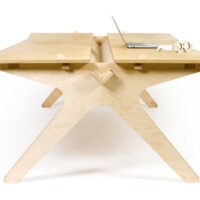For the first time ever, the National Endowment of the Arts took an in-depth look at the field of Industrial Design and yesterday released their report Valuing the Art of Industrial Design: A Profile of the Sector and Its Importance to Manufacturing, Technology, and Innovation. The results? Not surprisingly, being an industrial designer is pretty much just as cool as being a rock star.
Industrial Design Then and Now

“Industrial designers play a significant role in today’s innovation economy, and they bring a creative lens to approach complex problems or challenges…We hope this report provokes more discussion about how art works in the U.S. economy.”
-NEA Senior Deputy Chairman Joan Shigekawa
Ask any industrial designer who is a part of their industry and they’ll start listing off a myriad of spin-off categories of design: shoe design, transportation design, jewelry design, softgood design, interaction design, kinetic design, etc. Fortunately, Valuing the Art of Industrial Design took an expanded view of the field and defined industrial design as a field that “uses design thinking to design user experiences and systems and processes”.
Using fresh 2012 statistics (and prior) from the U.S. Bureau of Labor Statistics, the U.S. Census Bureau, and the United States Patent and Trademark Office to back their research into the field of Industrial Design, the 55-page report covers everything from which sectors are hiring, where industrial designers work, what they make, what their firms make, which states have the most patents, and other current statistics that every industrial designer should know.
Be sure to head over to the NEA’s site to read the full 55-page PDF. In the meantime, here’s some interesting statistics:
- There are more than 40,000 industrial designers in the United States.
- Thirty percent, or approximately 12,000 industrial designers, are
self-employed. - Among salaried workers, industrial designers number less than graphic
designers (191,440), merchandise-display designers (73,490), floral
designers (47,110), and interior designers (40,750)—but they earn more
than most design workers. - Most salaried industrial designers fall into one of two sectors:
manufacturing (11,730 workers) or professional, scientific, and technical
services (7,570 workers). - Michigan, Rhode Island, Wisconsin, Indiana, and Pennsylvania are the
top five states by percentage of industrial designers in the workforce. - Industrial designers in Michigan earn an average salary of $69,870 a
year, or $10,000 more than the national average for this occupation.
Industrial designers in Silicon Valley are also among the nation’s best-paid
industrial designers. - Over the next several years, a growing number of industrial designers
will find work in the professional services sector (e.g., engineering firms
and specialized design firms). - Roughly 14 percent (218) of all industrial design firms earned about $113
million by exporting their services. The sales accounted for roughly onefourth of these firms’ total revenue ($468 million). - Rhode Island, Oregon, Michigan, New York, and California rank in the top
five states by per-capita concentration of industrial design firms. - The number of U.S.-awarded design patents per 100,000 population
is at an all-time high: seven in 2012, compared with one at the turn of the
20th century. - Between 1998 and 2012, the U.S. Patent and Trademark Office
awarded 165,108 design patents (12,445 in 2012 alone) to U.S. companies
and individuals. - Manufacturing is projected to remain the largest employer of
industrial designers, despite a gradual reduction in the number of workers
employed in this sector.
(Above Images via Herman Miller and Sketch-a-Day)






